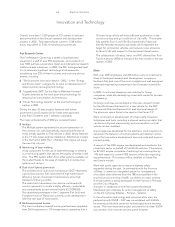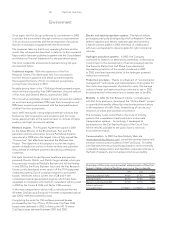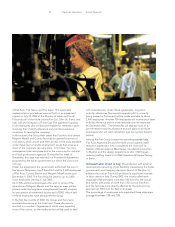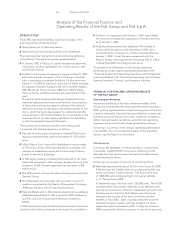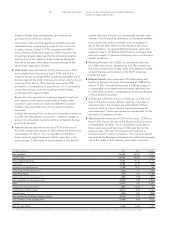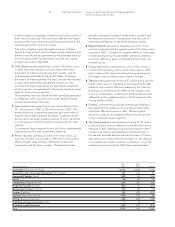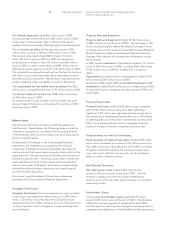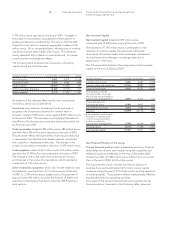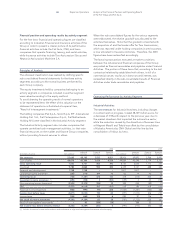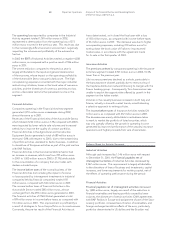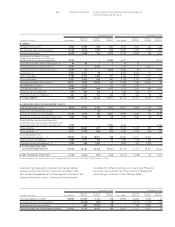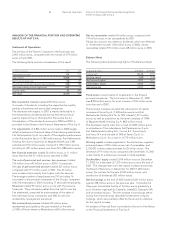Chrysler 2002 Annual Report Download - page 23
Download and view the complete annual report
Please find page 23 of the 2002 Chrysler annual report below. You can navigate through the pages in the report by either clicking on the pages listed below, or by using the keyword search tool below to find specific information within the annual report.
21 Report on Operations Analysis of the Financial Position and Operating Results
of the Fiat Group and Fiat S.p.A.
politics aimed at contrasting competitors and reduce stock of
both new and used cars. The result also suffered from higher
provisions that had to be set aside following extension of the
warranty period from one to two years.
Fiat Auto mitigated in part the negative impact of these
factors through product and overhead savings, realized in part
thanks to the efficiencies generated by the synergies deriving
from the alliance with General Motors and the cost cutting
program launched in May 2002.
❚CNH Global reported operating income of 163 million euros
in 2002, lower than the previous year’s result (209 million
euros) due to higher social security and medical costs for
its employees, especially in the United States. Excluding
the impact of these expenses, the Sector would have realized
a major improvement through greater margins on new
products and higher sales prices for agricultural equipment,
which more than compensated for the losses caused by lower
sales of construction equipment.
The operating result also benefited from synergies generated
by integration with Case and cost savings realized through
process enhancement measures.
❚Iveco posted lower operating income, which declined from
271 million euros in 2001 to 102 million euros in 2002. The
market downturn, competitive pressures, and lower sales of
engines unfavorably impacted the result. Furthermore, the
Sector had to set aside greater provisions to cover warranties
in consequence of vehicle recalls and lower prices for used
vehicles.
To counteract these negative factors, the Sector implemented
rigorous production cost containment measures.
❚Ferrari reported operating income of 70 million euros, up
from the 62 million euros posted in 2001 due to the positive
effect of higher sales volumes of Maserati models and
improved prices for Ferrari models. These benefits were
partially reduced by increased investments in research and
development activities for new products and the costs of
reintroducing Maserati on the North American market.
❚Magneti Marelli reported an operating loss of 16 million
euros as compared with the operating loss of 74 million euros
reported in 2001. It limited the negative effects of lower sales
volumes by disposing of unprofitable operations, realizing
production efficiency gains, and benefiting from lower raw
materials prices.
❚Comau reported an operating loss of 101 million euros, in
contrast with operating income of 60 million euros in 2001,
due to lower profit margins resulting from price pressures
and higher costs on several major orders in Europe.
❚Teksid posted operating income of 27 million euros, up from
the 15 million euros in operating income reported for 2001
thanks to high levels of efficiency realized by the Cast Iron
Business Unit and the positive effect of the change in the
scope of consolidation, as the Aluminum Business Unit had
suffered from the market downturn in North America in the
closing months of 2001.
❚FiatAvio continued enjoying high operating profitability in
fiscal 2002, with its operating income rising to 210 million
euros from 186 million euros in 2001. Efficiency gains
allowed it to absorb the negative effects of lower volumes
in the commercial engine segment.
❚Toro Assicurazioni posted operating income of 147 million
euros during the year, up sharply from the 68 million euros
reported in 2001, reflecting improved performance of the
insurance operations generated by portfolio selection in
the casualty business and the reduced frequency of claims.
Operating cost cutting measures and gains on the disposal
of real estate also made a positive contribution. Lower life
insurance premiums partially offset these improvements.
EBIT EBIT
(in millions of euros) 2002 2001 Change
Automobiles (Fiat Auto Holdings) (2,214)(1,061) (1,153)
Agricultural and Construction Equipment (CNH Global) 165 122 43
Commercial Vehicles (Iveco) (409)46(455)
Ferrari 44 62 (18)
Components (Magneti Marelli) (348)208 (556)
Production Systems (Comau) (247)30(277)
Metallurgical Products (Teksid) (137)(67) (70)
Aviation (FiatAvio) 183 495 (312)
Insurance (Toro Assicurazioni) (203)(134) (69)
Services (Business Solutions) (140)608 (748)
Publishing and Communications (Itedi) 1(4) 5
Miscellanea and Eliminations (650)223 (873)
Total (3,955)528 (4,483)





